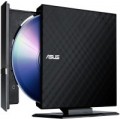Type
—
External. A drive designed to be connected as an external device. Such drives have a USB or eSATA interface (see "Connection") and are designed for frequent connection and disconnection. They are useful for laptops that do not have their own built-in drive, and for desktop PCs if there is no room in the case for installing an additional drive, or it needs to be connected to different computers.
—
External slim. The compact version of the external drive (see above) — these models have a much thinner thickness, which makes them especially convenient when transporting, for example, in a laptop bag.
—
Internal. Drives designed for installation in desktop PC cases, in 5.25" slots. They are installed as a permanently functioning part of the system and do not require frequent reconnection. The connection is made via the IDE or SATA interface (see "Connection").
—
Internal slim. A kind of internal drives (see above), designed for installation in laptops, where full-sized internal drives simply do not fit due to size. They differ in more compact dimensions (first of all, in thickness) and in the loading mechanism (for more details, see "Disk loading mechanism").
Writes
The types of optical discs that the drive can handle. In this case, we mean read-only work.
Historically, CD came first, then DVD, and even later, Blu-ray. The general rule for compatibility of discs and drives is as follows: earlier types of discs are readable in later drives, but not vice versa, and discs of the same type (for example, DVD) are interchangeable (with rare exceptions, which are discussed below).
The specific types of carriers used today are as follows:
—
CD-R. Recordable (once) CD. The standard capacity is 700 MB. Supported by all modern drives, regardless of type.
—
CD-RW. The rewritable CD version (see above) is also readable by almost all modern drives.
—
DVD+R. Recordable DVDs. Technically they are divided into DVD-R and DVD+R, in fact they do not differ in almost anything. Standard capacity — 4.7 GB; double-sided and double-layer recording can reach 17 GB, however, dual-layer discs are not supported by all drives.
—
DVD+RW. Rewritable DVD version (see above). Both DVD-RW and DVD+RW are supported almost without limitation by the corresponding drives.
—
DVD-RAM. A special kind of rewritable DVD — designed for frequent rewriting, withstand 100 times more rewrite cycles than RW, however, unlike other DVDs, they are not
...readable by all DVD drives. Initially, they were produced in protective cartridges, but later disks without cartridges and drives for them appeared; the possibility of operation of the drive with a cartridge should also be specified separately in each case.
— BD-ROM (Blu-Ray). High-capacity optical discs, originally designed to store high-definition video. The standard capacity is 25 GB, there are double-layer versions of 50 GB, but they are not supported by all drives. The index "ROM" means the impossibility of recording.
— BD-R (Blu-Ray). Blu-ray discs (see above) with write-once capability.
— BD-RE (Blu-Ray). Rewritable (Recordable Erasable) version of Blu-Ray discs (see above).DL (for DVD)
Possibility of operation of the drive with
two-layer DVD-discs(see "DVD±R"). The use of two layers for recording information doubles the capacity of the disc, but such media is only compatible with special drives.
Disc loading
—
Retractable. Drives with this type of loading are equipped with a drawer, which is controlled by a built-in electric motor — for its extension or loading, just press a button. This is the standard boot mechanism for most internal drives used in PCs (see "Type").
—
Retractable manual. In such drives, the button is used only to unlock the drawer — you have to pull it out and load it back manually. This loading mechanism is widely used in laptop drives (both internal and external), as it does not require power to load and unload the drive and saves battery life.
—
slotted. In such drives, the disk is loaded through a special slot in the case: the disk is inserted there somewhere up to half, after which it is picked up by a special mechanism and placed inside the drive; extracted in the same way. It is used mainly in slim-variations of drives, both internal and external (see "Type").
—
Manual. Drives with this loading have a disc compartment with a lid, similar to CD players. Opening the cover, inserting and removing the disc is done manually. Used in external drive models, can also be used in laptops. (see "Type").

